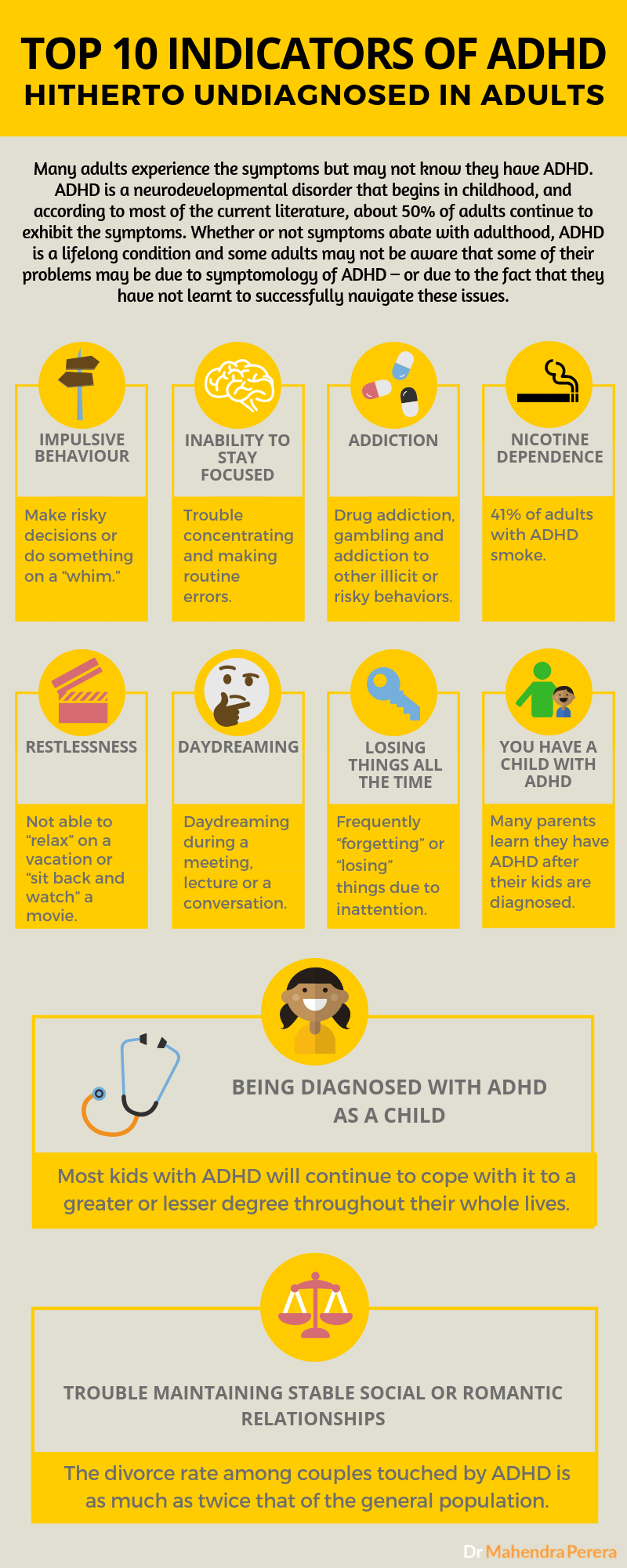What does undiagnosed ADHD look like in adults?
What does untreated ADHD look like in adults?
Untreated ADHD in adults can lead to mental health disorders like anxiety and depression. This is because ADHD symptoms can lead to focus, concentration, and impulsivity problems. When these problems are not managed effectively, they can lead to feelings of frustration, irritability, and low self-esteem.
How can you tell if someone has ADHD undiagnosed?
Failing to pay attention to details or constantly making careless mistakes. Often having trouble organizing tasks and activities. Often avoiding tasks that require mental effort over a long period of time. Often losing things necessary for tasks and activities (e.g. wallets, keys, paperwork, eyeglasses, cell phones).
Can adults have ADHD and it might be undiagnosed?
ADHD often goes undiagnosed and untreated because the symptoms often look different in adulthood than in childhood. Other factors including lack of awareness and the masking or self-medicating of symptoms can also play a role.
What is undiagnosed ADHD in adults masking?
If you hide your adult ADHD symptoms from other people, that’s called masking. Basically, you’re trying to seem more “normal” or “regular.” ADHD causes some people to act hyperactive or impulsive. It makes other folks have trouble paying attention.
What could be mistaken as ADHD?
If your child seems hyperactive–fidgety, impulsive, and inattentive–don’t automatically assume that they have attention deficit hyperactivity disorder (ADHD). Anxiety, depression, learning disorders, physical health, and many other conditions can cause symptoms that look like ADHD but aren’t.
What happens if ADHD goes unnoticed?
If left untreated in childhood or adulthood, the symptoms of ADHD (hyperactivity, inattention, and impulsiveness) can lead to behavioral, emotional, social, academic, and vocational problems.
What could be mistaken for ADHD?
If your child seems hyperactive–fidgety, impulsive, and inattentive–don’t automatically assume that they have attention deficit hyperactivity disorder (ADHD). Anxiety, depression, learning disorders, physical health, and many other conditions can cause symptoms that look like ADHD but aren’t.
How does ADHD manifest in adults?
People with ADHD experience an ongoing pattern of the following types of symptoms: Inattention–having difficulty paying attention. Hyperactivity–having too much energy or moving and talking too much. Impulsivity–acting without thinking or having difficulty with self-control.
What is ADHD mirroring?
One type of ADHD masking — known as mirroring — involves intentionally or unintentionally mimicking the speech, movements, or behaviors of someone else. While ADHD mirroring and body doubling may seem similar at first glance, you can work alongside a body double without imitating them in any way.
What are the signs of ADHD in female adults?
Symptoms Impulsiveness. Disorganization and problems prioritizing. Poor time management skills. Problems focusing on a task. Trouble multitasking. Excessive activity or restlessness. Poor planning. Low frustration tolerance.
What do ADHD mood swings look like?
People with ADHD also tend to feel anger, anxiety, frustration, or dis…

What does untreated ADHD look like in adults
Untreated ADHD in adults can lead to mental health disorders like anxiety and depression. This is because ADHD symptoms can lead to focus, concentration, and impulsivity problems. When these problems are not managed effectively, they can lead to feelings of frustration, irritability, and low self-esteem.
Cached
How can you tell if someone has ADHD undiagnosed
Failing to pay attention to details or constantly making careless mistakes. Often having trouble organizing tasks and activities. Often avoiding tasks that require mental effort over a long period of time. Often losing things necessary for tasks and activities (e.g. wallets, keys, paperwork, eyeglasses, cell phones).
Cached
Can adults have ADHD and it might be undiagnosed
ADHD often goes undiagnosed and untreated because the symptoms often look different in adulthood than in childhood. Other factors including lack of awareness and the masking or self-medicating of symptoms can also play a role.
Cached
What is undiagnosed ADHD in adults masking
If you hide your adult ADHD symptoms from other people, that's called masking. Basically, you're trying to seem more “normal” or “regular.” ADHD causes some people to act hyperactive or impulsive. It makes other folks have trouble paying attention.
What could be mistaken as ADHD
If your child seems hyperactive–fidgety, impulsive, and inattentive–don't automatically assume that they have attention deficit hyperactivity disorder (ADHD). Anxiety, depression, learning disorders, physical health, and many other conditions can cause symptoms that look like ADHD but aren't.
What happens if ADHD goes unnoticed
If left untreated in childhood or adulthood, the symptoms of ADHD (hyperactivity, inattention, and impulsiveness) can lead to behavioral, emotional, social, academic, and vocational problems.
What could be mistaken for ADHD
If your child seems hyperactive–fidgety, impulsive, and inattentive–don't automatically assume that they have attention deficit hyperactivity disorder (ADHD). Anxiety, depression, learning disorders, physical health, and many other conditions can cause symptoms that look like ADHD but aren't.
How does ADHD manifest in adults
People with ADHD experience an ongoing pattern of the following types of symptoms: Inattention–having difficulty paying attention. Hyperactivity–having too much energy or moving and talking too much. Impulsivity–acting without thinking or having difficulty with self-control.
What is ADHD mirroring
One type of ADHD masking — known as mirroring — involves intentionally or unintentionally mimicking the speech, movements, or behaviors of someone else. While ADHD mirroring and body doubling may seem similar at first glance, you can work alongside a body double without imitating them in any way.
What are the signs of ADHD in female adults
SymptomsImpulsiveness.Disorganization and problems prioritizing.Poor time management skills.Problems focusing on a task.Trouble multitasking.Excessive activity or restlessness.Poor planning.Low frustration tolerance.
What do ADHD mood swings look like
People with ADHD also tend to feel anger, anxiety, frustration, or disappointment more intensely than others. (The same can be true of positive emotions.) They can have trouble putting the brakes on their feelings.
What are the traits of ADHD in adults
Some specialists have suggested the following as a list of symptoms associated with ADHD in adults:carelessness and lack of attention to detail.continually starting new tasks before finishing old ones.poor organisational skills.inability to focus or prioritise.continually losing or misplacing things.forgetfulness.
What feels like ADHD but isn t
If your child seems hyperactive–fidgety, impulsive, and inattentive–don't automatically assume that they have attention deficit hyperactivity disorder (ADHD). Anxiety, depression, learning disorders, physical health, and many other conditions can cause symptoms that look like ADHD but aren't.
What are the 3 main symptoms of ADHD
The 3 categories of symptoms of ADHD include the following:Inattention: Short attention span for age (difficulty sustaining attention) Difficulty listening to others.Impulsivity: Often interrupts others.Hyperactivity: Seems to be in constant motion; runs or climbs, at times with no apparent goal except motion.
What are the 3 types of ADHD in adults
Types and causes of ADHDADHD – inattentive. Inattentive ADHD, commonly known as ADD, accounts for about 33% of all ADHD in adults.ADHD – hyperactive & impulsive. Hyperactive and impulsive ADHD accounts for 7% of all ADHD in adults.ADHD – combined.
How can you tell if someone is masking ADHD
using so much energy to seem “fine” that you do not have enough left to function or enjoy life. hiding your feelings and denying yourself emotional support from friends and family. behaving as if you do not have ADHD and missing out on a diagnosis and treatment.
What is an example of stimming with ADHD
Stimming can take many different forms: visual: staring off into space, drawing, spinning things like pens or coins. verbal/auditory: repeating sounds, excessive giggling, constantly clearing throat. tactile: rubbing fingers, chewing/biting nails, chewing the inside of cheeks.
What does untreated ADHD look like in girls
Interestingly, girls with untreated ADHD may be more likely to blame and judge themselves for these problems, leading to a higher risk for low self-esteem than boys who have ADHD. They may also be more likely to have problems with substance abuse, eating disorders, and anxiety.
What are the 3 main symptoms of ADHD in adults
Some specialists have suggested the following as a list of symptoms associated with ADHD in adults:carelessness and lack of attention to detail.continually starting new tasks before finishing old ones.poor organisational skills.inability to focus or prioritise.continually losing or misplacing things.forgetfulness.
What are the personality shifts of ADHD
It's often characterized by difficulty focusing, restlessness, and impulsive behaviors. Shifts in mood — often called “mood swings” — are common for people with ADHD, and there are many ways to cope.
What are unusual symptoms of ADHD
Atypical Presentation of ADHD Symptoms
Impaired sense of time (loses track of time, often late, hates waiting, avoids doing homework, etc.) Sleep disturbances (has trouble with sleep initiation, sleep deprived, can't wake up easily, etc.)
What disorders are commonly mistaken for ADHD
Conditions That Mimic ADHDBipolar disorder.Autism.Low blood sugar levels.Sensory processing disorder.Sleep disorders.Hearing problems.Kids being kids.
What is ADHD most commonly misdiagnosed as
Generalized anxiety disorder (GAD; anxiety)
When you have ADHD, there's a lot to be anxious about! It's no wonder half of us are diagnosed with an anxiety disorder. While you'll often spot the two together, some clinicians are quick to diagnose anxiety, but not ADHD.
What are the 5 stages of ADHD
When a client comes back to me with an ADHD diagnosis, they almost always follow this discrete series of stages.Phase One: Excitement/Relief.Phase Two: Investigation.Phase Three: Frustration.Phase Four: Acceptance.Phase Five: Application.
How do I know if I have ADHD as an adult
Adults with ADHD may find it difficult to focus and prioritize, leading to missed deadlines and forgotten meetings or social plans. The inability to control impulses can range from impatience waiting in line or driving in traffic to mood swings and outbursts of anger. Adult ADHD symptoms may include: Impulsiveness.



0 Comments